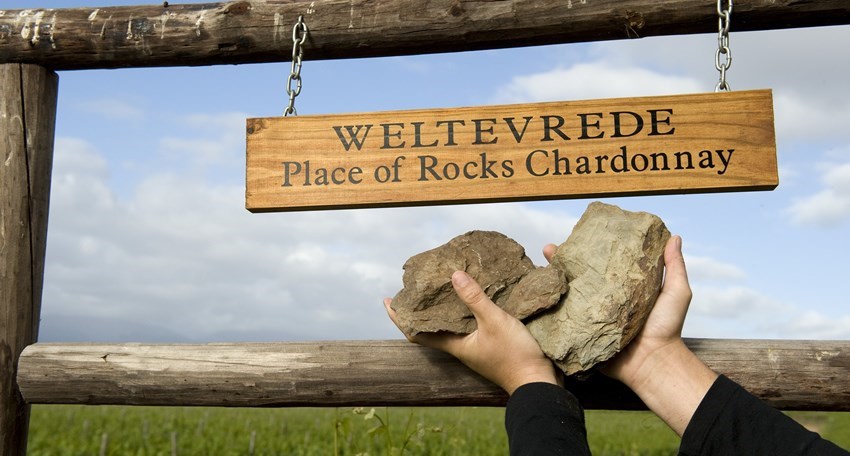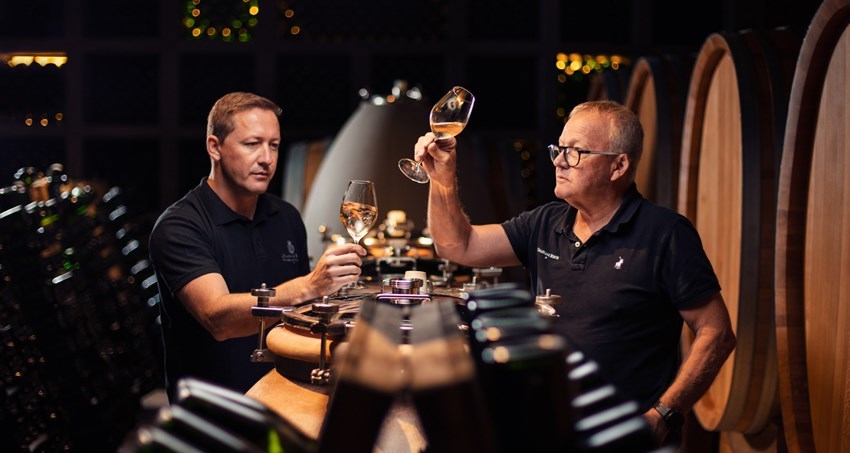A second fermentation is brewing in the Robertson Wine Valley. On the fiftieth anniversary of the first vintage of bottle-fermented sparkling wine at Simonsig in 1971, producers in the Robertson Wine Valley have come together to launch a new Cap Classique route. Highlighting the limestone terroir and hero variety of the region, Chardonnay, the initiative combines the strengths of specialist MCC houses such as Graham Beck, Bon Courage, Silverthorn, Paul René, Lord’s and Weltevrede – as well as MCC producers such as VRL Van Loveren, Viljoensdrift and Ilse Schutte’s Bemind Wyne.
John Loubser, cellar master of Silverthorn, is one of the driving forces behind the new MCC route. Over a tasting of the four acclaimed MCC wines in his portfolio, he says, “The Blanc de Blanc style will define the Robertson region. What makes Robertson so special is our Chardonnay (28% of all plantings of the variety in SA are in the region). The secret is our soils – the calcareous nature of the shale with limestone veins. What sets us apart is the terroir. Most MCC’s are stylistically driven.”
Passing around fossils excavated in the area from his fascinating collection on display in the tasting room, John demonstrates his passion for these ancient soils. His award-winning portfolio of MCC – The new River Dragon (made from 38 year-old vine Colombard fermented in acacia barrels, is named after draco Africanus), The Green Man (from an old 1992 Chardonnay vineyard), the Genie Shiraz Rosé and Jewel Box Brut (named after a cluster of stars in the southern sky) – are all inspired by the mythical landscape. He adds, “We’re not hemmed in by champagne protocols or specific varieties. Sparkling wine is made from different varieties all over the world, from Spain and Italy to Germany.”
Over in Bonnievale, Weltevrede unveiled its new chic MCC tasting lounge, underground tasting bar and museum which opens in late October. In a major rebranding exercise, cellar master Philip Jonker has created a window for his flagship range of MCC – separating his Cap Classique wines from their portfolio of still wines. Welcoming the first visitors to the new facility, Philip stood in front of the landscaped cellar where two rows of transplanted 1926 muscat vines planted by his great-grandfather lead to the new MCC cellar. Over the coming season, visitors will be able to disgorge, dosage, cork, seal, wire, label and finish a bottle of MCC on a boutique, handcrafted production line.
A journey into the MCC experience takes visitors from the traditional A-frame pupitres (laths) where bottles of MCC lie fermenting into the underground kuipe carved out from rock – past displays which explain the many stages of making sparkling wine and black-and-white art posters which capture the glamour of champagne with quotes by Noel Coward, Winston Churchill, and Olivia de Havilland. Another display explains the origins of sparkling wines in different countries from cava to prosecco. Hands up if you know the name for collectors of the muselet (wire basket) is placomusophilia?
A soundtrack of French chanteurs and Italian opera leads to a stylish underground MCC bar where Philip conducts a tasting of his classic Entheos MCC Brut blend of Chardonnay and Pinot Noir and The Ring Blanc de Blanc. Since making his first vintage of MCC at Weltevrede in 1994, Cap Classique has become his passion. He comments, “We hit the refresh button during the Covid pandemic – and refocused on MCC. Our new MCC tasting centre highlights the significance of the Robertson terroir within the context of Cap Classique in the Western Cape – and throughout the world. We want to showcase the signature lime character and chalky minerality of our soils and Chardonnay. Vintage variation plays a key role. I use the same vintage of the same wine for my ‘magic potion’ (dosage) You know that every bottle of our handcrafted MCC is handled eighty times from start to finish!”

Bon Courage is another key destination on the new Robertson Cap Classique route. Award-winning cellar master Jacques Bruwer has been making their flagship MCC at this renowned family farm for thirty years since 1991. The plush new tasting lounge and visitor centre is a showpiece for the category. A firm believer in a vintage style of Cap Classique, Bon Courage only releases his wines – Jacques Bruére (after the family’s French Huguenot ancestor) Blanc de Blancs, Brut Reserve and CuvéeRosé - after they have spent up to eight years on the lees. Over a tasting of the 2012 vintage of all three of the wines – paired with artisanal nougat – Jacques spoke about his purist approach.
“We planted our first Chardonnay at Bon Courage in 1983. A vintage MCC should be at least ten years old as in Champagne. Making MCC is a waiting game. The longevity of Chardonnay wines with the right ph grown in limestone soils is critical – as is the Pinot Noir planted on the poorest Karoo soils on the farm. I’m big on letting nature shape the wine. I merely guide it through the cellar. Our Brut Reserve is an elegant, classic blend of Pinot Noir and Chardonnay from two single vineyards.”
Every stop we made along the new MCC route highlighted an intriguing variation on the Cap Classique theme, a unique take on “the sweet spot” (a constant refrain) and underscored the signature chalky qualities of Robertson Chardonnay. At Van Loveren, cellar master presented his new-look label of Christina MCC Brut and Brut Rosé. They hold back 2500 to 5000 litres of wine every year to blend into the next vintage of Cap Classique – and with 30% of the vineyards planted on limestone, the magical qualities of Robertson Chardonnay are guaranteed. They now make 12 500 bottles of each style. Along the way, we tasted Viljoensdrift Pinot Noir Rosé MCC and Bemind’s quirky MCC made from 100% Chenin Blanc grapes by Ilse Schutte at her boutique cellar in McGregor.
At Lord’s Wines set against a spectacular backdrop of mountains and vineyards, Jacques Oosthuizen, the owner’s son, presented a tasting of three MCC wines in another new tasting centre on the route. Since making their first MCC in 2012, their focus too has become MCC which now comprises over 50% of total production – grown in the highest Chardonnay and Pinot Noir vineyards in the valley at 500m above sea level. The wines are made in the zero dosage style, creating a scintillating fresh house style of Brut Rosé and Brut MCC. We were the first to taste Lord’s new limited release(300 bottles) of the maiden 2012 Brut Vintage left on lees for seven years, under a stunning bronzed label.
And at Paul René, another of the specialist MCC houses on the Robertson Cap Classique route, we stopped to taste the stylish portfolio made by winemaker Henk van Niekerk on the old family farm Wonderfontein (1885). The courtyard of the old Georgian homestead is an exquisite setting for a tasting of his acclaimed MCC wines – the Paul René Chardonnay Brut 2017 won the Old Mutual Show Trophy for Cap Classique in 2021 among a host of awards. Grown in limestone, shale and red Karoo soils on both sides of the Breede River, the MCCs made here are as elegant as the label. We also tasted a refreshing aperitif of Nectar MCC made in the fast-growing demi-sec style. Paul René hosts the popular annual Splash of Pink MCC festival on the first Saturday of November in 2021.
The Robertson Collective celebrated the launch of the Cap Classique route at Mo & Rose guest-house in the Klaas Voogds Valley over dinner created by Christophe de Hosse of Glenelly, Joostenberg and Stark-Condé. A superb pairing of food and Cap Classiquewas hosted by the seven limestone cowboys. Over the flagship Cuvée Clive MCC Chardonnay 2017, Pieter “Bubbles” Ferreira, the legendary cellar master who has made thirty vintages of MCC at Graham Beck’s landmark Robertson cellar since 1991, spoke about the phenomenal growth of the Cap Classique category. The MCC Association has grown from 12 signatories in 1991 to 104 members today, to 257 MCC brands – while the Amorim Cap Classique Challenge celebrates its twentieth anniversary this month.

Pieter quips, “Where do the grapes come from to make all this MCC? During harvest time I sit in my cellar on the hill and watch through binoculars branded winery trucks from other wine regions heading home carrying Chardonnay grapes from Robertson. If you see wine of origin: Western Cape on an MCC label, it usually means the grapes were grown in the Robertson Wine Valley!”
To be continued: Graham Howe visits Graham Beck to experience their new wave of MCC tastings